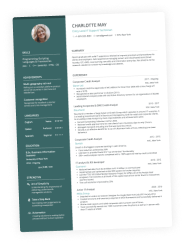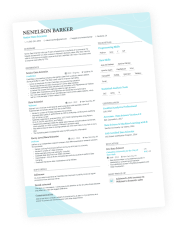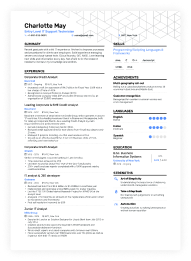But ending a cover letter isn’t as simple as typing “Sincerely” and moving on. Depending on whether you’re sending it by email, uploading a PDF, or printing it, your sign-off might need different formatting—and the right sign-off can subtly boost your credibility.
This guide shows you how to end your cover letter professionally—what to write, how to format it, and when a signature is necessary.
Key takeaways
- Reinforce your professionalism with a confident, well-formatted cover letter sign-off.
- Include your full name below the sign-off, and add a handwritten signature only for printed letters.
- Match your closing tone to the industry—use formal sign-offs for traditional roles and warmer options for creative fields.
- Use a typed name as your cover letter signature for all digital submissions.
- Proofread your final paragraph and sign-off section to eliminate typos and formatting errors.
Before we dive in, generate a tailored cover letter from your resume and let your application stand out from start to finish.
Drop your resume here or choose a file.
PDF & DOCX only. Max 2MB file size.
Digital vs. printed cover letter sign-offs: what’s the difference?
Understanding how to sign a cover letter depends heavily on how you’re submitting it.
Digital or emailed submissions: A typed full name is enough—no scanned signature needed.
Printed or mailed cover letters: Always leave enough space to sign your name in ink between your closing phrase and the typed name.
How to sign off a cover letter professionally
Signing off on a cover letter isn't just about choosing a polite phrase—it's about wrapping up your message with confidence and formatting the final details correctly for the type of submission you're using.
Whether you’re sending it digitally or printing it out, your closing should follow clear conventions that make you appear professional, organized, and respectful of the application process.
Formatting checklist for the perfect closing
- Capitalize only the first word of the closing phrase (e.g., “Best regards”) followed by a comma.
- Place your full name below the sign-off, as your typed name serves as your digital signature.
- If you’re submitting a printed letter, leave two to three line spaces between the closing phrase and your typed name for a handwritten signature.
- Add your contact information below your name if it’s not already listed in a header or footer. Typically, that means your phone number and email, with LinkedIn as an optional addition.
- Include “Enclosure: Resume” to prompt the reader to check the attachment.
Once your formatting is in place, it’s time to return to the content itself—specifically, how to wrap up your letter before the sign-off.
Craft your final paragraph before the sign-off
Before you type your closing phrase, take a moment to strengthen your final paragraph. This is your last chance to reaffirm your enthusiasm for the role, show initiative, and express appreciation.
Example of a strong final paragraph
I’m excited about the opportunity to bring my skills to your team and would welcome the chance to discuss how I can support your goals. Please don’t hesitate to contact me to schedule an interview. Thank you for your time and consideration.
A sentence like that sets up a natural transition to your formal sign-off—and shows you’re serious about moving forward.
In the next section, we’ll break down which sign-offs work best by industry and tone, so you can choose the one that fits your situation.
Cover letter sign-off examples
Once you've written a strong final paragraph and chosen a professional closing phrase, it's time to pull everything together with a polished sign-off. Your formatting and tone should align with the role and company culture—whether you're submitting it digitally or by mail.
Here’s how to format your sign-off, with examples grouped by communication style:
Formal tone
Best for legal, government, finance, and other traditional or conservative industries. These sign-offs are respectful, reserved, and time-tested:
- Sincerely,
- Yours truly,
- Respectfully,
Professional but friendly
A safe, widely accepted tone for most industries—including corporate, healthcare, education, and general business. These closings strike a balance between politeness and approachability:
- Best regards,
- Kind regards,
- With appreciation,
Conversational and confident
Ideal for startups, creative roles, or companies with a casual tone. These closings express interest while maintaining professionalism:
- Thank you for your time.
- Looking forward to your response.
- I appreciate your consideration.
Example 1: Standard digital submission
For email or uploaded PDFs, a typed name and clean formatting are enough. You don’t need a physical signature.
Sincerely,
John Doe
(123) 456-7XXX
john.doe@enhancv.com
linkedin.com/in/johndoe
Example 2: Printed letter with signature
When printing a cover letter, leave three blank lines between the closing and your typed name to sign by hand.
Best regards,
[Handwritten Signature]
Jane Doe
(987) 654-3XXX
jane.doe@enhancv.com
Use these cover letter templates as a starting point, but feel free to adapt them to your voice and the company’s tone. Just make sure the final lines of your cover letter look as professional as the rest of your application.
Mistakes to avoid in your cover letter sign-off
Even a well-written cover letter can lose its effectiveness if the sign-off feels rushed, casual, or poorly formatted.
Avoid these common mistakes to leave a strong final impression:
- Using casual closings: Avoid phrases like “Cheers,” “Thanks!” or “Take care.” They can feel too informal or mismatched for professional applications.
- Leaving out your name: Always include your full name below the closing phrase—your name is essential, even in emailed cover letters and e-notes.
- Forgetting to update your sign-off: If you're reusing a template, make sure the closing phrase fits the tone of the job you're applying for.
- Including quotes or emojis: Adding humor, inspirational quotes, or emojis can undermine the professionalism of your message.
- Skipping a handwritten signature on printed letters: For mailed applications, always leave space to sign above your typed name.
- Allowing typos or formatting inconsistencies: Double-check punctuation, spacing, and contact details for avoidable errors.
Conclusion
The final lines of your cover letter can leave a lasting impression—make them count. Whether you’re submitting digitally or in print, the right sign-off shows you’re thoughtful, refined, and ready to take the next step.
Choose a closing phrase that fits the role, format it cleanly, and leave no detail unfinished. Now that you know how to end your cover letter, see how others have done it well with these cover letter examples.
Want to save time? Build a tailored cover letter from your resume and ensure your application—from greeting to signature—is polished and job-ready.




